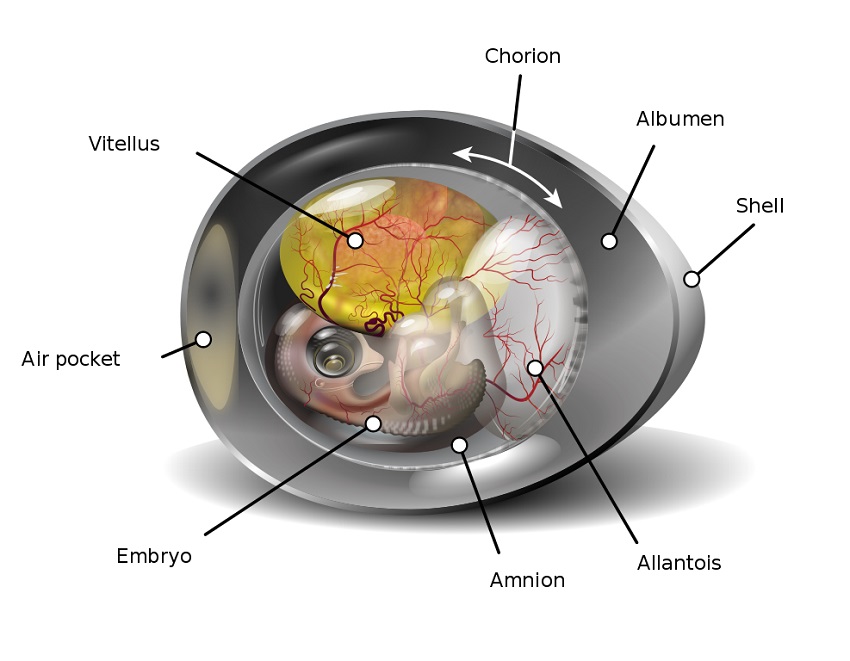Definition of amniotes
Amniotes are vertebrate organisms that have an tissue fetal tissue known as amnion. The amnion is a membrane derived from fetal tissue that surrounds and protects the amnion. fetus. The amnion may be found inside the egg, as in lizards and birds, or the amnion may simply enclose the foetus inside the egg. uterus.
Amniotes include most vertebrates, excluding fish and amphibians. Fish and amphibians are anamniotes, meaning “without amnion”. The eggs of these species are often laid in water, which protects them from damage or crushing. Most amniotes, by contrast, are terrestrial and require the amnion to protect the developing foetus under the weight of gravity. The only exceptions to this are whales, which live an entirely aquatic life. They developed an amnion before their ancestors returned to the sea. Some sea turtles also like the sea, but return to land to lay their eggs, which necessitates the amnion.
Characteristics of amniotes
All amniotes have three membranes surrounding the foetus of an offspring. These membranes are the amnion or protective layer, the upper layer of the chorion and the allantois which absorbs the debris. These layers can be seen in the image of a hen’s egg, below.

While amniotes share a number of other characteristics in general (being vertebrates, tetrapods, etc.), they all evolved from a common ancestor that developed the amniote character. The amnion is seen in egg-laying species such as birds and reptiles, as well as mammals. Although human eggs have lost their shells, they are in many ways identical to chicken eggs as they develop inside the uterus.
Animals considered amniotes
Sauropsid amniotes
There are two main divisions of amniotes, the amniotes sauropsids and amniotes synapsids. The sauropsid amniotes include the reptiles and birds. Formally, this constitutes many different groups, but the sauropsid amniotes share many derived characteristics that separate them from the synapsids. The two groups evolved at roughly the same time, from a common ancestor that was probably not terrestrial.
This means that both synapsids and sauropsids had to adapt to the new terrestrial environment in different ways. These differences are mainly reflected in the heart, lungs and kidneys. In sauropsids, you will generally find lungs faveolarswhich differ from the lungs of synapsids. Faveolar lungs have small chambers that open into a common space. The heart heart of sauropsids lacks a ventricle permanently divided. While some sauropsids (turtles and crocodilians) have evolved hearts that have almost 4 chambers, they are not the synapsid heart with a physical separation between the ventricles.
Sauropsid amniotes also excrete waste differently from synapsids. The sauropsids typically excrete uric acid (the white paste in bird faeces). This substance is precipitated out of the urine in the cloacawhere much of the water can be reabsorbed. This makes uric acid a more water-efficient way of excreting nitrogenous waste, compared to the synapsid method. Sauropsids include turtles, lizards, crocodiles and birds. They generally lay eggs, although there are some exceptions.
Synapsid amniotes
The synapsid amniotes do things slightly differently, as they split from the sauropsids millions of years ago. The synapsid strategy for expelling waste, for example, is typically all urea. Urea can be concentrated in the synapsid kidney and excreted with small chunks of water. While this may not be as water-efficient as uric acid, it is much more efficient than excreting pure ammonia, which is what fish and amphibians typically do.
The synapsid heart has 4 chambers, with a well-defined partition between the ventricles. This improves the efficiency of oxygenation of the heart. bloodby ensuring separate pathways for blood to go to and from the heart. The synapsids evolved different lungs from the sauropsids. The synapsid lung is a lung aveolar . Instead of small pockets of a central chamber, the aveolar lung has many tracheal branches, each of which ends in an aveolar sac.
There are only 3 groups of synapsids, all of which are. mammals. While all these amniotes still have amniotic sacs, they also have very different methods of reproduction. The monotremessuch as the platypusstill lay eggs in nests. When the young are born, they feed them with milk from the glands of their skinlike all other mammals. The marsupials represent a median between monotremes and placental mammals. They develop their young inside a uterus, but the young are born at an extremely early age. They must crawl along the mother’s body to the marsupial pouchwhere they can feed on milk for the rest of their development.
Placental mammals represent the remaining synapsid amniotes. These animals use a placenta, u oxygen and nutrients that pass through the maternal membrane to feed and nourish the young in utero. At birth, the offspring of these animals are comparatively the largest of all amniotes. However, placental mammals also have fewer offspring compared to sauropsid amniotes.
Evolution of amniotes
Amniotes probably arose when many of the earliest land animals ventured onto land. The very different terrestrial environment is probably what drove the divisions between the two main groups of amniotes. This probably occurred in the Devonian period about 400 million years ago. Since then, the two groups have evolved considerable differences in their anatomy y physiologyas discussed above. At that time, the new terrestrial environment provided a number of new niches for animals to fill, which also significantly diversified them.
Below is a organism that may have been a common ancestor of modern amniotes. This is a parieasaur, a cow-sized organism from the Devonian period. This large, reptilian-looking organism probably had primitive lungs, heart and kidneys. It also probably had an amnion, making it one of the earliest amniotes.

Find out more about the amnion here.
